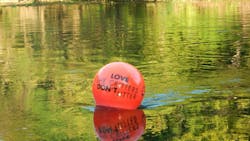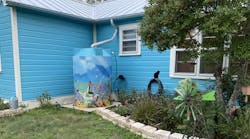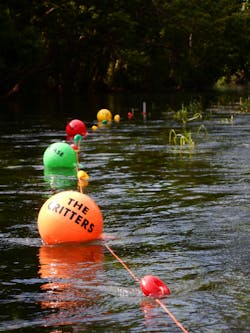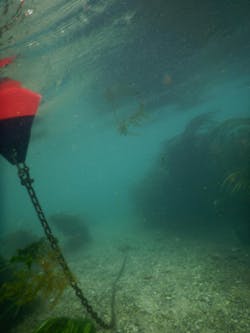Making your mark in water
The San Marcos River in Texas is host to numerous recreational visitors, which poses a challenge to Texas Wild Rice, an endangered plant species found only in the San Marcos River. Thus, this fostered a collaboration between the city of San Marcos (project stakeholder) and a graduate student (project designer) to develop a system of buoys marking areas of the plants, encouraging river recreation traffic to avoid protected areas.
As a signatory of the Edwards Aquifer Habitat Conservation Plan (EAHCP), the city of San Marcos is charged to conserve protected species habitat—in this case Texas Wild Rice.
Conservation measures implemented include aquatic vegetation restoration, face-to-face education, signage, and installation of TWR enclosures during flows less than 120 cfs (trigger point). This buoy project has accomplished the last two measures, while adding playful and simple messaging to further promote environmental stewardship.
This challenge is not special to Texas, with many states and cities playing host to both visitors and endangered plant species. The following offers thought starters for others who might having similar needs to communicate with audiences within or near a body of water.
Think of the following as a springboard to support your project:
- Identify opportunities - What problems need solving? How can we help?
- Gather ideas - explore the possibilities, with imagination!
- Test concepts - make sure your ideas are viable.
- Make updates - change as needed to address issues or improve.
- Build your project - make your vision a reality.
- Measure results- find out what impact you’ve had.
Questions to get started
Before worrying about what you are going to put in the water, work to understand the problem being solved. Are you trying to warn of danger? Is there something to draw attention to? Maybe influence behavior in or around the water? It is tempting to jump in and start creating, but exploration and testing can save time and effort, maybe materials—possibly yielding more effective ideas. Whatever happens, try to keep an open mind.
Questions to focus on what is important:
- What are we trying to do here, exactly?
- Who is our audience and what is their understanding of the place where we are working?
- Who should we talk to that may be affected or provide useful knowledge?
- What or who will benefit from this project?
Questions focused on the water environment:
- What kind of environment are you working in?
- Is there a strong current or are the water levels changing?
- What is the bottom like—is there soft sediment, gravel or rock?
- What happens in flood conditions?
- Would the installation stay in the water year-round or is it seasonal?
- What challenges are presented with installation and, if required, removal?
- Are people or animals going to encounter what is placed in the water?
Answers to the questions listed will help you plan and develop a deeper appreciation for your own project and likely discover opportunities. The project team worked to determine where to place buoys, considering: water depths, a powerful current, flooding, areas to protect from river traffic, and behaviors to influence for the better of the river.
Potential Solutions
Prototypes are excellent for testing ideas. Iteration also helps, in this case it led to a durable installation that has stood the test of time–sometimes leaving buoys in the river for over a year. Buoys come in many shapes and sizes and are made for many uses. Depending how they are tethered, they float on their sides or vertically. Water movement can further affect floatation.
The project plans called for floating vertically so graphics and messages would be visible. Larger buoys are more buoyant. Changing conditions, including water levels, can impact the work. Added slack in ropes and chains will allow your installation to simply float up if water levels rise. Too much tension and rising waters could submerge your efforts.
Posts of varying lengths were used to secure lines of buoys between posts. A “post hammer” was used to drive posts as much as 6 feet down. Other areas were too rocky for posts. If the river bottom is soft, shed anchors can hold a line of buoys very nicely. A combination of chain and rope met needs in the San Marcos. Seek out materials that resist corrosion, such as galvanized chain. Rope offers the ease of connecting buoys using knots. There are many ways to connect everything together — think of how buoys will be attached.
Options tested and used in this project included; U-brackets, D-Shackles, carabiners, cable ties, and Loctite metal glue. D-shackles made it easy to connect buoys to chains. Carabiners on the river bottom connected chains to shed anchors for ease of removal if needed. Cable ties secured chains to carabiners. If there are concerns about things breaking loose or tampering, Loctite makes a glue that permanently bonds metal, and in this case, project, the team used it with a D-shackle.
Failed attempts and equipment are your friends. The first installation of this project washed downstream after heavy rains, fortunately preventing any false hope our concept could withstand rough conditions. Do not be tempted into buying things that look like buoys such as exercise balls made of thin vinyl. Cheaper items are likely to fail, possibly doubling your efforts and adding costs, but this does not mean you need top of the line gear to be successful.
Getting visuals was a key to this project. After many experiments, the team arrived at a solution for graphics and messages using facts and humor on buoys. Stencils and vinyl paint (automotive vinyl paint) created durable visuals.
Use your imagination to communicate through your project. This design sought to increase understanding of the San Marcos River, “giving the river a voice.” Consider the tone of your messages. The San Marcos team’s approach avoided phrases like “DO NOT ENTER” and worked to be clear and inform and delight while also establishing boundaries. Signs were also placed in the river to supplement messaging on buoys. Signs were subject to being submerged in floods; taller posts helped to cope with rising waters.
Consider staging your installation to ensure you have everything, including tools to complete work — before going into the field. Be ready to improvise. Despite testing buoys beforehand, on installation day it was discovered they tipped sideways, hiding messages. Short lengths of chain were quickly cut and attached to the buoys to act as weights to fix the issue.
It may be helpful to see if your efforts are having an impact. San Marcos stakeholders wanted to divert river traffic away from protected Texas Wild Rice. A game camera made it possible to track traffic before and after the buoys were placed in the water, capturing thousands of photos. Before the buoys, it was not uncommon for recreational traffic to float into protected areas. After placing buoys in the river it was clear to see people avoiding the protected area, and if they accidentally drifted in, most of them worked to get themselves out.
About the Author
Eric Weeks
Eric Weeks earned his B.S. in Resource & Environmental Studies at Texas State University. He manages the Conservation Crew, for the city of San Marcos, who educate river users of habitat protections, manage litter, and enhance Texas Wild Rice habitat.
Andrea Weissenbuehler
Andrea Weissenbuehler earned her MFA in Communication Design at Texas State University. The buoy project was her graduate thesis project. Her relationship with the city of San Marcos continues years after graduation.





